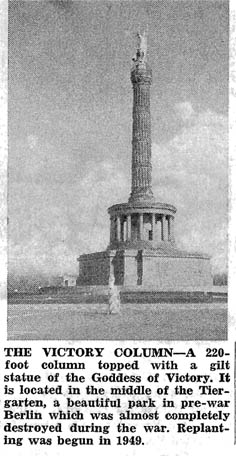|
Midway along the Strasse des 17.Juni stands one of the more conspicuous landmarks in the district of Tiergarten-the Siegessaeule, other
wise known as the Victory Column.
The monument, more than 200 feet tall, was built by Kaiser Wilhelm to
commemorate the wars of 1864, 1866 and 1870 and to mark the unification
of the German states. Cornerstoned in 1865, the structure was completed
in 1873 and unveiled on September 2, of that year-the day of the victory
at Sedan,Originally located on what was then known as the King’s Parade
Ground (an area between the Reichstag and the Congress Hall which is
known today as the Platz der Republik), the memorial was moved to
its present location on the Grosser Stern in 1938.
The monument is set on an eight step granite foundation with a square
red marble base supporting the column. An Italian glass mosaic circles the
column above the foundation, illustrating the events of 1870-71 and the
restoration of the German Empire. Four rows of gilded gun barrels
adorn the sandstone column and the upper platform is borne by stone
eagles. Atop the spire rests the golden Victory Goddess, extending in one hand the laurel wreath of the Caesars and in the other a scepter topped by an Iron Cross. With her sweeping wings pressed against the Berlin sky, she gazes eastward to the Wall and the Brandenburg Gate just beyond.
The area surrounding the column is dotted with dozens of statues. Some of these date back hundreds of years to the days when the Tiergarten was remodeled in the French style, while others were added after World War II. Among the more prominent of these carvings are the family group of Kaiser Wilhelm and the full length portrait statues of famous Prussian generals.
The Victory tower is open to visitors who wish to climb the 285-step spiral staircase to the observation platform from 10 a.m. to 5 p.m. daily from March to October. The view afforded from this vantage point
over the city is a must for camera bugs.
Within the forested area of the Tiergarten Park are many more sculptures to be seen. The National Memorial to Prince Bismarck is one
of the most entriguing. Bismarck is shown in his cuirassier’s uniform, as he was want to appear in the old Reichstag. Four groups encircle the base of the pedestal: in front, Atlas bearing the globe; behind, Siegfried forging the imperial sword; on the right, a woman treading a panther underfoot (symbolic of the constitutional power of the state in suppressing sedition); to the left, a sphinx supporting a
woman encrossed in a document (statesmanship).
Adjacent to Bismarck’s monument are smaller ones dedicated to Field
Marshal von Moltke and Minister of War Von Roon, both dating from the
turn of the century. Others within the gardens depict various hunting
activities.
The Brandenburg Gate, although not a part of the Tiergarten and
now divorced from West Berlin by the ’Wal1, has been the scene of important events in the city’s past.
Easily viewed from the Siegessaeule, the six-column Boric sandstone gate is a replica of the Propylaea in Athens, It was constructed
bv order of Frederick the Great and finished in 1719. Later, a statue of
the Goddess of Victory driving a chariot pulled by four horses-the
Quadriga-was placed on top of the structure, facing in the opposite
direction of which it does today.
For two centuries the Brandenburg Gate was the triumphant entrance
for victorious Prussian troops foreign rulers and dignitaries, state
wrocessions and even victorious armies of other nations.
French troops marched through the gate after defeating the Prussians in the Napoleonic Wars. Napoleon had the six-ton Quadriga dismantled and carted off to Paris. Before the French could comwletely erect the Quadriga, however, Napoleon was defeated and the chariot returned to Berlin.
Revolutionaries were fired on at the Gate in 1314 as they made their
way to the palace of Friedrich Wilhelm IV. In 1871 victorious German
troops filed through the gate following the defeat of France in the
France-Prussian War.
German troops marched down Unter den Linden and under the Gate once more in 1914 on their way to the front in World War I. When that war ended Communist forces tried to take the city. German soldiers coming back from the front retraced their steps through the Gate and squelched the Communist attempt of takeover.
Nazi Storm Troopers paraded up Unter den Linden and through the Gate in January 1933, announcing the arrival of Hitler’s “new Germany” to the world, After France and the Low Countries were defeated in 1940, the monument was again the scene of a victorious army’s parade, German soldiers marched through the monument for the last time in 1945, but this time as the prisoners of the Russians.
Although no more armies marched through the Gate, world attention
once again focused on it on June 17, 1953, when workers in East Berlin
challenged the Red regieme. It is in memory to the challenge that the
street in West Berlin that runs down toward the gate is today called the
Strasse des 17. Juni.
|

